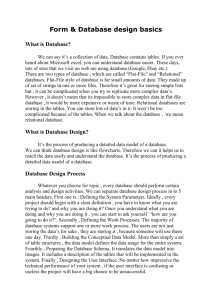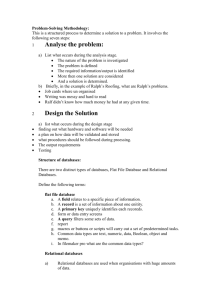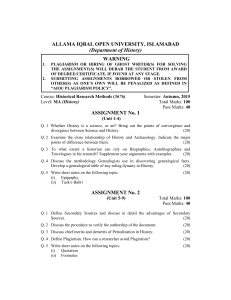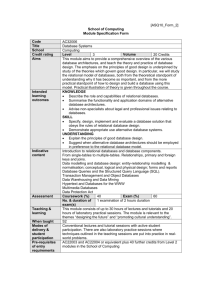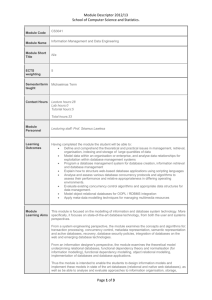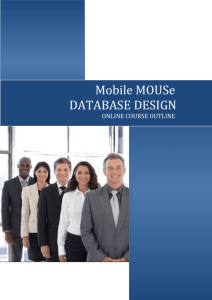- Allama Iqbal Open University
advertisement
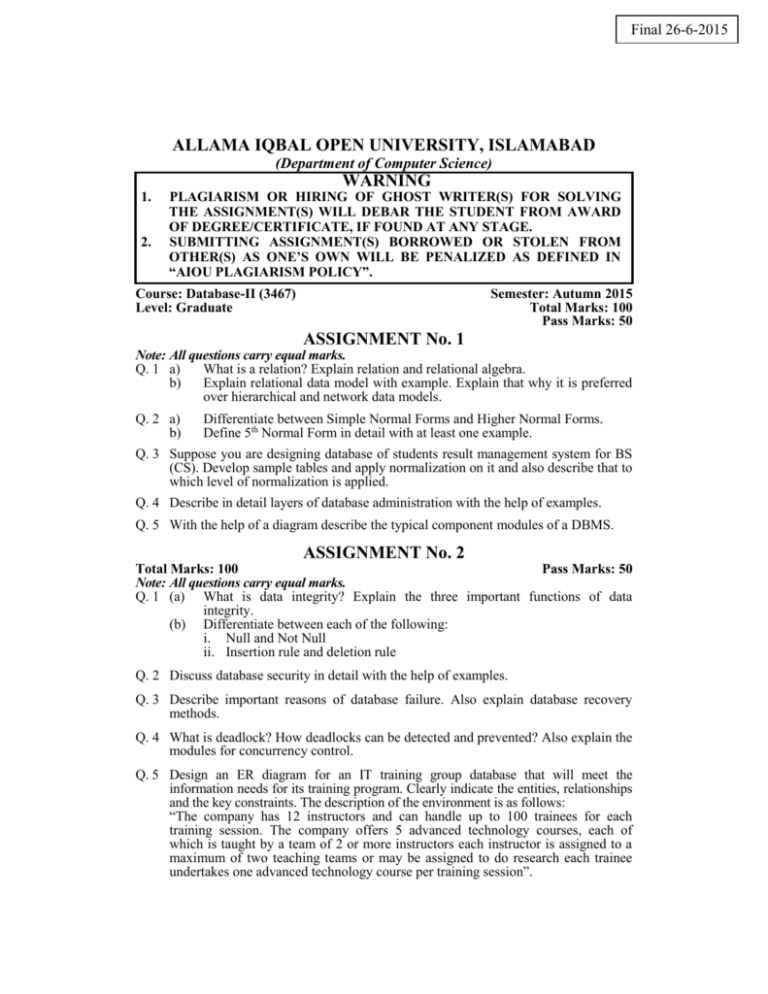
Final 26-6-2015 ALLAMA IQBAL OPEN UNIVERSITY, ISLAMABAD (Department of Computer Science) WARNING 1. 2. PLAGIARISM OR HIRING OF GHOST WRITER(S) FOR SOLVING THE ASSIGNMENT(S) WILL DEBAR THE STUDENT FROM AWARD OF DEGREE/CERTIFICATE, IF FOUND AT ANY STAGE. SUBMITTING ASSIGNMENT(S) BORROWED OR STOLEN FROM OTHER(S) AS ONE’S OWN WILL BE PENALIZED AS DEFINED IN “AIOU PLAGIARISM POLICY”. Course: Database-II (3467) Level: Graduate Semester: Autumn 2015 Total Marks: 100 Pass Marks: 50 ASSIGNMENT No. 1 Note: All questions carry equal marks. Q. 1 a) What is a relation? Explain relation and relational algebra. b) Explain relational data model with example. Explain that why it is preferred over hierarchical and network data models. Q. 2 a) b) Differentiate between Simple Normal Forms and Higher Normal Forms. Define 5th Normal Form in detail with at least one example. Q. 3 Suppose you are designing database of students result management system for BS (CS). Develop sample tables and apply normalization on it and also describe that to which level of normalization is applied. Q. 4 Describe in detail layers of database administration with the help of examples. Q. 5 With the help of a diagram describe the typical component modules of a DBMS. ASSIGNMENT No. 2 Total Marks: 100 Pass Marks: 50 Note: All questions carry equal marks. Q. 1 (a) What is data integrity? Explain the three important functions of data integrity. (b) Differentiate between each of the following: i. Null and Not Null ii. Insertion rule and deletion rule Q. 2 Discuss database security in detail with the help of examples. Q. 3 Describe important reasons of database failure. Also explain database recovery methods. Q. 4 What is deadlock? How deadlocks can be detected and prevented? Also explain the modules for concurrency control. Q. 5 Design an ER diagram for an IT training group database that will meet the information needs for its training program. Clearly indicate the entities, relationships and the key constraints. The description of the environment is as follows: “The company has 12 instructors and can handle up to 100 trainees for each training session. The company offers 5 advanced technology courses, each of which is taught by a team of 2 or more instructors each instructor is assigned to a maximum of two teaching teams or may be assigned to do research each trainee undertakes one advanced technology course per training session”. 3467 Database-II Credit Hours: 3 (3 + 0) Recommended Book: Modern Database Management 4th Edition by Jeffrey Hoffer Course Outlines: Unit–1 Overview of Database Modeling Techniques, Data Models, Relational Database Management System, Relation and Its Properties, Relational Algebra Unit–2 Higher Normal Forms Overview of Simple Normal Forms, Higher Normal Forms, Boyce-Codd Normal Form, 4th Normal Form, 5th Normal Form Unit–3 Database Administration Introduction, Layers of Database Responsibilities Administration, DBA Functions and Unit–4 Database Integrity Introduction, Integrity Rules (Entity Integrity, Referential Integrity (Insertion Rule, Deletion rule (Restrict, Nullify, Cascade))), Ranges of Values, Not Null, Selection Based Entry (Radio Buttons, Check Boxes, Lov) Unit–5 Database Security Introduction, Physical Security (Locks, Logbooks, Staff Categorization), Database Security (View, Authorization Table (Subject, Object, Privileges), User Defined procedures, Encryption) Unit–6 Database Recovery Introduction, Reasons of Database Failure, Database Recovery Facilities, Backup, Logs (Transaction Log, Database Change Log), Database Recovery Methods (Restore, Roll Forward, Roll Backward), Transaction Processing Unit–7 Database Concurrency Introduction, Problem of Lost Updating, concurrency control Methods (Optimistic Approach, Pessimistic Approach), Managing the Deadlock, Transaction Integrity Unit–8 Distributed Databases Introduction, Types of Distributed Databases, Advantages and Disadvantages of Distributed Databases Unit–9 Object Oriented Databases Introduction to Object Oriented Paradigm, Differences in Object Model and Relational Model, Object Oriented Analysis and Design, Costs and Benefits of Object Databases 2





